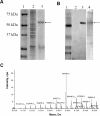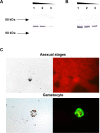Recombinant Pvs48/45 antigen expressed in E. coli generates antibodies that block malaria transmission in Anopheles albimanus mosquitoes
- PMID: 25775466
- PMCID: PMC4361554
- DOI: 10.1371/journal.pone.0119335
Recombinant Pvs48/45 antigen expressed in E. coli generates antibodies that block malaria transmission in Anopheles albimanus mosquitoes
Retraction in
-
Retraction: Recombinant Pvs48/45 Antigen Expressed in E. coli Generates Antibodies that Block Malaria Transmission in Anopheles albimanus Mosquitoes.PLoS One. 2025 Jan 15;20(1):e0317791. doi: 10.1371/journal.pone.0317791. eCollection 2025. PLoS One. 2025. PMID: 39813263 Free PMC article. No abstract available.
Abstract
Transmission of malaria parasites from humans to Anopheles mosquitoes can be inhibited by specific antibodies elicited during malaria infection, which target surface Plasmodium gametocyte/gamete proteins. Some of these proteins may have potential for vaccine development. Pvs48/45 is a P. vivax gametocyte surface antigen orthologous to Pfs48/45, which may play a role during parasite fertilization and thus has potential for transmission blocking (TB) activity. Here we describe the expression of a recombinant Pvs48/45 protein expressed in Escherichia coli as a ∼60kDa construct which we tested for antigenicity using human sera and for its immunogenicity and transmission blocking activity of specific anti-mouse and anti-monkey Pvs48/45 antibodies. The protein reacted with sera of individuals from malaria-endemic areas and in addition induced specific IgG antibody responses in BALB/c mice and Aotus l. griseimembra monkeys. Sera from both immunized animal species recognized native P. vivax protein in Western blot (WB) and immunofluorescence assays. Moreover, sera from immunized mice and monkeys produced significant inhibition of parasite transmission to An. Albimanus mosquitoes as shown by membrane feeding assays. Results indicate the presence of reactive epitopes in the Pvs48/45 recombinant product that induce antibodies with TB activity. Further testing of this protein is ongoing to determine its vaccine potential.
Conflict of interest statement
Figures





References
-
- WHO (2013) World malaria report World Health Organization; Geneva: Available: http://www.who.int/malaria/publications/world_malaria_report_2013/report....
-
- Baird J (1998) Age dependent characteristics of protection v. susceptibility to Plasmodium falciparum . Ann Trop Med Parasitol 92: 367–390. - PubMed
-
- Snow RW, Omumbo JA, Lowe B, Molyneux CS, Obiero J-O, et al. (1997) Relation between severe malaria morbidity in children and level of Plasmodium falciparum transmission in Africa. Lancet 349: 1650–1654. - PubMed
Publication types
MeSH terms
Substances
Grants and funding
LinkOut - more resources
Full Text Sources
Other Literature Sources

